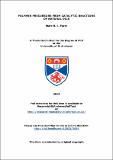Files in this item
Polymer precursors from catalytic reactions of natural oils
Item metadata
| dc.contributor.advisor | Cole-Hamilton, D. J. (David John) | |
| dc.contributor.author | Furst, Marc R. L. | |
| dc.coverage.spatial | 144 | en_US |
| dc.date.accessioned | 2013-06-13T09:52:48Z | |
| dc.date.available | 2013-06-13T09:52:48Z | |
| dc.date.issued | 2013-06-26 | |
| dc.identifier | uk.bl.ethos.574800 | |
| dc.identifier.uri | https://hdl.handle.net/10023/3684 | |
| dc.description.abstract | The bidentate ligand 1,2-bis(ditertbutylphosphinomethyl)benzene has been shown to be a very efficient catalyst for operating the alkoxycarbonylation of alkenes and unsaturated esters and carboxylic acids giving a very high selectivity to the linear product with very few exceptions to this general rule. Due to the increasing prices of petroleum feedstock and petroleum-derived chemicals, the preparation of chemicals starting from renewable resources and waste products from the industry becomes an interesting alternative. Fatty acids and fatty esters, due to the existence of one or more unsaturation in their alkyl chain are subjected to the alkoxycarbonylation reactions in presence of 1,2-bis(ditertbutylphosphinomethyl)benzene, palladium, methane sulfonic acid, carbon monoxide and methanol, yielding diesters with a long carbon chain (up to 19 carbon atoms). The diesters are shown to be readily prepared from unpurified olive, rapeseed or sunflower oils as well as from tall oil. In the last case triesters are also formed. The diesters are subjected to hydrogenation in the presence of 1,1,1-tris(diphenylphosphinomethyl)ethane, ruthenium and hydrogen, in a mixture of dioxane and water at high temperature, yielding the corresponding diols. The resulting products of the reactions are monomers for preparing polyesters having the potential to replace some existing petroleum-based polymers (for instance polyethylene). The aminocarboxylation reaction in the presence of the same palladium/1,2-bis(ditertbutylphosphinomethyl) benzene catalyst, in the presence of aniline, 2{naphthol and potassium iodide in diethylether, is employed for preparing esteramides, which are subjected to hydrogenation. Aromatic polyamides are prepared by melting together an aromatic diamine and diacids obtained from methoxycarbonylation. Finally, N-Heterocyclic Carbene (NHC) ligands are employed for preparing new palladium complexes which are used in the Suzuki-Miyaura cross-coupling reaction in a water/isopropanol mixture. Other complexes based on copper are employed for developing an inexpensive transmetallation reaction for transferring a NHC ligand from copper to palladium and gold. | en_US |
| dc.language.iso | en | en_US |
| dc.publisher | University of St Andrews | |
| dc.subject | Green chemistry | en_US |
| dc.subject | Natural oils | en_US |
| dc.subject | Palladium | en_US |
| dc.subject | Ruthenium | en_US |
| dc.subject | Methoxycarbonylation | en_US |
| dc.subject | Hydrogenation | en_US |
| dc.subject | Polymers | en_US |
| dc.subject | NHC | en_US |
| dc.subject.lcc | QD505.F8 | |
| dc.subject.lcsh | Catalysis--Research | en_US |
| dc.subject.lcsh | Polymerization--Research | en_US |
| dc.subject.lcsh | Polymers--Synthesis | en_US |
| dc.subject.lcsh | Oils and fats | en_US |
| dc.title | Polymer precursors from catalytic reactions of natural oils | en_US |
| dc.type | Thesis | en_US |
| dc.type.qualificationlevel | Doctoral | en_US |
| dc.type.qualificationname | PhD Doctor of Philosophy | en_US |
| dc.publisher.institution | The University of St Andrews | en_US |
This item appears in the following Collection(s)
Items in the St Andrews Research Repository are protected by copyright, with all rights reserved, unless otherwise indicated.

